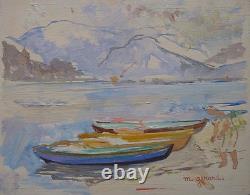
- Home
- Artist
- André Poirson (4)
- Anonymous (5)
- Bouquier (3)
- Claude Revardeau (2)
- Clery Pierpont (2)
- Contemporary (5)
- Courtine (2)
- Felicia Butel (2)
- Henri Royet (2)
- Illegible (2)
- Jean-paul Ulysse (4)
- Maurice Barle (2)
- Maurice Bismuth (2)
- Pierre Jaillet (2)
- Renoir (3)
- René Lévy (2)
- Siarnowski (2)
- Unknown (3)
- Unsigned (4)
- Werner Gilles (2)
- Other (4944)
- Characteristics
- Boxed (2)
- Framed (23)
- Framed, On Canvas (11)
- Framed, On Panel (2)
- Framed, On Wood (37)
- Framed, Signed (4)
- Miniature (3)
- On Canvas (8)
- On Panel (25)
- On Wood (128)
- On Wood, On Canvas (6)
- On Wood, On Panel (15)
- On Wood, Signed (3)
- Signed (13)
- Signed, On Canvas (13)
- Signed, On Panel (10)
- Signed, On Wood (56)
- Other (4640)
- Genre
- Abstrait (59)
- Académisme (57)
- Art Déco (50)
- Barbizon (27)
- Baroque (86)
- Classicism (75)
- Classicisme (225)
- Expressionism (155)
- Expressionnisme (160)
- Fauvism (34)
- Fauvisme (53)
- Impressionism (183)
- Impressionnisme (497)
- Impressionniste (33)
- Orientalisme (74)
- Orientaliste (26)
- Realism (61)
- Renaissance (28)
- Romantisme (116)
- Réalisme (204)
- Other (2796)
- Style
- 1900 (12)
- 1900 Ou Avant (6)
- 1910-1920 (6)
- 1920 (9)
- 1920-1930 (26)
- 1920-1940 (9)
- 20th Century Style (15)
- Contemporary (7)
- Non-spécifié (59)
- Not Specified (18)
- Unspecified (51)
- École De Barbizon (12)
- 1930 (16)
- 1930-1940 (17)
- 1940-1950 (6)
- 1940-1960 (238)
- 1940 (26)
- 1970 (46)
- 1980 (23)
- 1990 (12)
- Other (4385)
- Theme
- Abstract (7)
- Animals (27)
- Architecture (8)
- Art (2)
- Character (62)
- Child (4)
- Flower, Tree (15)
- Flowers (2)
- Genre Scene (39)
- History, War (5)
- Horse Portrait. (2)
- Hunting, Fishing (5)
- Landscape (306)
- Marine (3)
- Nude (2)
- Nude Woman (2)
- Portrait (9)
- Religion, Mythology (22)
- Seascape, Boat (52)
- Still Life (48)
- Other (4377)
- Type
Maud GERARD (1915-2013) Oil on wood 19x24cm 1948 Belgian School Impressionism




Very beautiful Oil on Wood. 7.5" x 9.4" in. She studied at Henriette BOSCHÉ's studio in 1931.
Afterwards, she entered the Royal Academy of Fine Arts in Brussels in 1931. She studied painting with Anto Carte from 1935 to 1937. Winner of the annual painting competition of the Academy of Fine Arts in Brussels in 1937. She studied with Isidore Opsomer at the Institute of Painting in Antwerp. A scholarship recipient of the "Prix de Rome," she stayed in Rome in 1941.
She exhibited at the Galerie de la Licorne in Brussels in 1942. Solo exhibition at the Palais des Beaux Arts in Brussels in 1948. She exhibited at the Galerie Breughel in Brussels in 1952 and 1955.
She traveled extensively in Europe, Africa, New York, Washington, and South America. Maud Gerard was a long-lived British-born artist who was heavily influenced by the French Impressionists, so much so that she went to live and study in Belgium, where she was to spend the vast majority of her life. From the studio of the artist, these are beautifully handled and highly collectible. In 1931, Gerard enrolled in the Académie Royale des Beaux-Arts de Bruxelles, where she studied under Henriette Bosché (later being invited to work at that painter's studio).A trip during 1936 to Paris brought her into contact with paintings by Monet, the water lilies series being a particular favorite. Often very delicately colored, her work is a fascinating combination of Impressionism, Post-Impressionism, and on occasion, Cubism. After a short period under the instruction of Anto Carte (1935-37), her breakthrough came in 1937 when she won the annual painting competition of the Academy of Fine Arts in Brussels. Later, by invitation, Gerard studied with Isidore Opsomer at the Institute of Antwerp. Her legacy was cemented as early as 1948 when she was invited to hold a solo exhibition of her work at the Beaux Arts de Bruxelles to much acclaim.
The Figurative Alternative or the Young Painting. After the Second World War, the 1950s in France were characterized by the expression of existential questions, reflecting the anxieties and uncertainties of a humanity that discovered the extent of Nazi horror, followed by the disillusionments of the Cold War. This period revealed a new generation of painters matured prematurely by the sufferings and deprivations of the dark years. They proposed a vision of the world where Man, and not Idea, occupies a central place.Half a century has passed. The time has come to pay tribute to these artists, to these collectors, both public and private, who took it upon themselves to defend a figurative alternative in the face of conquering abstraction.
Françoise Adnet, Paul Aïzpiri, Jean-Pierre Alaux, Guy Bardone, Richard Bellias, André Brasilier, Bernard Buffet, Jacques Busse, Jean-Marie Calmettes, Jean Chevolleau, Paul Collomb, Jean Commère, Jean Cortot, Daniel Dalmbert, Michel de Gallard, René Genis, Raymond Guerrier, Vincent Guignebert, Paul Guiramand, Camille Hilaire, Jean Jansem, Jacques Lagrange, Bernard Lorjou, Jean Marzelle, André Minaux, Marcel Mouly, Michel Patrix, Pierre-Henry, Jean Pollet, Raoul Pradier, Daniel Ravel, Paul Rebeyrolle, Claude Schürr, Michel Thompson, Maurice Verdier, Claude Weisbuch, Nouvelle École de Paris.
